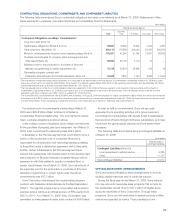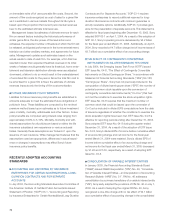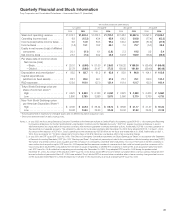Sony 2006 Annual Report Download - page 73
Download and view the complete annual report
Please find page 73 of the 2006 Sony annual report below. You can navigate through the pages in the report by either clicking on the pages listed below, or by using the keyword search tool below to find specific information within the annual report. 71
for Common Stock of ¥12.5 per share to each shareholder;
accordingly, the total annual cash dividend per share of
Common Stock is ¥25.0.
All shares of shares of Subsidiary Tracking Stock, the
economic value of which was intended to be linked with Sony
Communication Network Corporation’s economic value, were
converted to shares of Sony Common Stock on Thursday,
December 1, 2005.
NUMBER OF EMPLOYEES
The number of employees at the end of March 2006 was
approximately 158,500, an increase of approximately 7,000
employees from the end of March 2005. Although there was a
reduction in employees associated with the implementation of
restructuring activities in Japan, the U.S., Europe and Southeast
Asia, the total number of employees increased as a result of a
significant increase in employees at manufacturing facilities in
East Asia.
TREND INFORMATION
This section contains forward-looking statements about the
possible future performance of Sony and should be read in light of
the cautionary statement on that subject, which appears on the
inside front cover and which applies to this entire document.
ISSUES FACING SONY AND MANAGEMENT’S RESPONSE
TO THOSE ISSUES
Competition in many of Sony’s business segments continues to
intensify and price erosion, especially in the Electronics seg-
ment, remains persistent. Competition has intensified due to the
penetration of broadband, which has led to an augmentation of
network infrastructure, making it easier for companies in other
sectors to enter the markets in which Sony competes.
In response to these challenges, Sony has been undertaking
initiatives to improve its competitiveness and strengthen the
quality of its management, such as a reduction in the number of
business categories and the number of models, a rationalization
of manufacturing sites and the creation of a more efficient
administrative structure, as well as the sale of non-core assets
(See “Restructuring” in “Operating and Financial Review” for
more detailed information about restructuring). This plan,
developed in consultation with Sony’s stakeholders both inside
and outside the company, moved to strengthen Sony’s competi-
tiveness in three core sectors—Electronics, Game and Entertain-
ment—through a balanced mix of restructuring and growth
initiatives combined with a new organizational structure. In
particular, it is the revitalization of Electronics that management
regards as the most pressing issue confronting Sony today. As
well as reorganizing its Electronics business to place centralized
decision-making authority over key areas under the Electronics
CEO, Sony is implementing reorganization initiatives to
strengthen horizontal coordination in the key areas of product
planning, technology, procurement, manufacturing, and sales
and marketing. For Sony’s growth strategy in Electronics,
resources will be focused on the development and commercial-
ization of high-definition products, mobile products and advanced
semiconductors and other key devices that can further differentiate
these products, targeting enhanced competitiveness and
improved profitability.
In addition to this cost-cutting and investment for growth,
each of Sony’s business segments grappled with issues specific
to that segment. Below is a description of the issues manage-
ment believes each segment continues to face and an explana-
tion as to how each segment is approaching those issues.
■ELECTRONICS
Although the Electronics segment continues to hold a very
strong position in the worldwide consumer audio visual products
market, that position has become increasingly threatened as a
result of the entrance of new manufacturers and distributors.
These new entrants are threatening Sony’s position due to the
industry shift from analog to digital technology. In the analog era,
complicated functionality of electronics products was made
possible through the combination of several complex parts, and
Sony held a competitive advantage in the design and manufac-
ture of those parts as a result of its accumulated expertise. In
the digital era, however, complicated functionality has become
concentrated on semiconductors and other key digital devices.
Since these semiconductors and key devices are able to be
mass produced, they have become readily available to new
market entrants, and the functionality that once commanded a
high premium has become more affordable. This has led to
intense price erosion in the consumer audio visual products
market. To respond to these challenges, Sony is striving to keep
pace with price erosion by reducing its manufacturing and other
costs. It is seeking to maintain the premium pricing it enjoys on
many of its end-user products by adding functionality to those
products and developing new applications and ways of use that
appeal to the consumer. In addition, it is taking steps to increase
its competitive edge by developing high value-added semicon-
ductors and other digital key devices in-house. By enhancing
the in-house production of key devices, Sony aims to incorporate
added-value into these key devices.
























